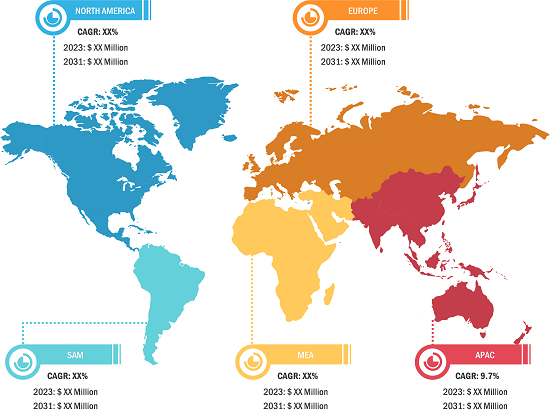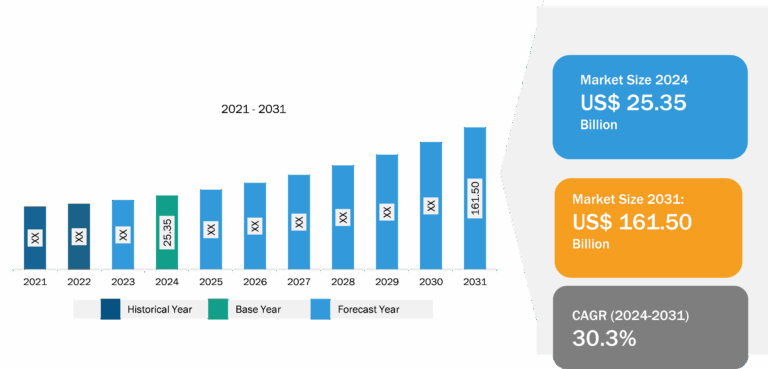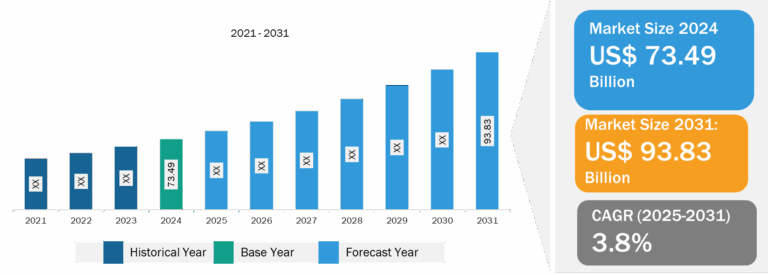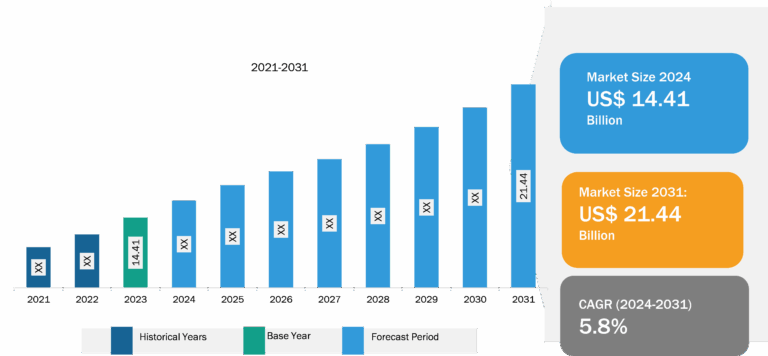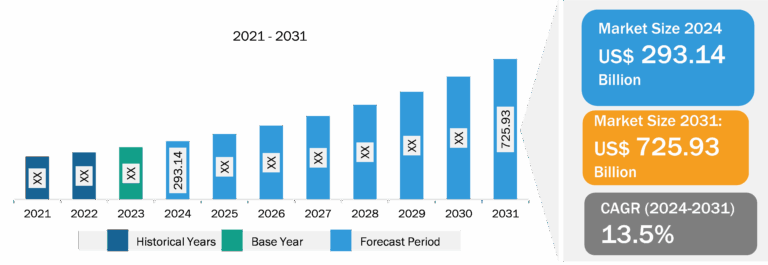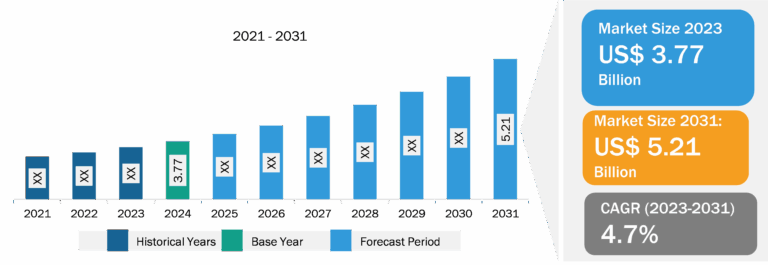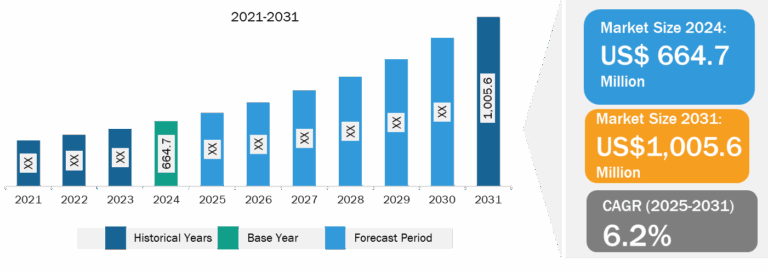
Big Data Analytics Market
According to a new comprehensive report from The Insight Partners, the big data analytics market is observing significant growth owing to increasing demand for data-driven decision making and growing adoption and investment in cloud computing.
The report runs an in-depth analysis of market trends, key players, and future opportunities. In general, the big data analytics is applicable in a vast array of industry verticals that are expected to register strength during the coming years.

Overview of Report Findings
- Market Growth: The big data analytics market is expected to reach US$ 725.93 billion by 2031 from US 293.14 billion in 2024, at a CAGR of 13.5% during the forecast period. Big data analytics involves the systematic processing and analysis of large, complex datasets (big data) to extract valuable insights. It enables the identification of trends, patterns, and correlations within vast amounts of raw data, assisting analysts in making data-driven decisions. This process empowers organizations to harness the rapidly growing data from diverse sources such as IoT sensors, social media, financial transactions, and smart devices, transforming it into actionable intelligence through advanced analytics. In the early 2000s, advancements in software and hardware allowed businesses to manage large volumes of unstructured data, prompting open-source communities to develop big data frameworks for distributed storage and processing. These frameworks, along with additional tools and libraries, facilitate tasks such as predictive modeling using AI and statistical algorithms; in-depth statistical analysis; scenario simulation via what-if analysis; and processing of structured, semi-structured, and unstructured data. Four primary data analysis methods—descriptive, diagnostic, predictive, and prescriptive—help organizations uncover insights and patterns, enhancing their understanding of market trends, customer preferences, and key business metrics.
- Increasing Demand for Data-Driven Decision Making: The increasing demand for data-driven decision-making drives the big data analytics market. As businesses, governments, and organizations face heightened competition and the need for operational efficiency, there is a growing recognition that data—when analyzed effectively—can provide deep insights that impact strategic decisions. Companies are looking to leverage the abundance of information at their disposal to improve day-to-day activities as well as gain a competitive edge in the market. Big data analytics presents organizations with the tools to analyze vast amounts of organized and unstructured data, allowing decision-makers to make informed choices.
- Rising Demand from Small and Medium Enterprises: The growing demand from small and medium enterprises (SMEs) is likely to present substantial opportunities for the growth of the big data analytics market during the forecast period. SMEs are often characterized by their agility and adaptability, enabling them to develop tailored solutions that meet specific customer needs more effectively than larger corporations. SMEs, which represented approximately 99% of all businesses in the European Union in 2022, are often more agile and innovative and adopt advanced technologies such as big data analytics to enhance operational efficiency. Moreover, in 2021, according to the Organization for Economic Co-operation and Development (OECD), SMEs play a crucial role in the economic growth of many countries, contributing approximately 50% of total employment and 40% of gross domestic product (GDP). Further, according to the study conducted by the Singapore University of Social Sciences (SUSS) in 2024, many SMEs are missing out on significant cost-saving opportunities by not utilizing data analytics. The study further reveals that businesses implementing data analytics can reduce operational costs by up to 10%, as the technology helps identify inefficiencies in supply chains and staffing models.
Market Segmentation
- Based on component, the big data analytics market is segmented into software and services. The software segment held the largest market share in 2024.
- Based on deployment, the big data analytics market is segmented into cloud and on-premises. The cloud segment held the largest market share in 2024.
- Based on application, the big data analytics market is segmented into customer analytics, marketing analytics, pricing analytics, workforce analytics, and others. The others segment held the largest market share in 2024.
- Based on end user industry, the big data analytics market is segmented into IT and telecom, BFSI, healthcare, retail, and others. The others segment held the largest market share in 2024.
- The big data analytics market is segmented into five major regions: North America, Europe, Asia Pacific (APAC), the Middle East & Africa (MEA), and South & Central America.
Competitive Strategy and Development
- Key Players: A few major companies operating in the big data analytics market include Amazon Web Services Inc., FICO, Hewlett Packard Enterprise Co, International Business Machines Corp, Microsoft Corp, Oracle Corp, SAP SE, SAS Institute Inc., TIBCO Software Inc., and Teradata Corp.
- Trending Topics: Augmented analytics, real-time and streaming analytics, cloud-based analytics, integration of IoT data, among others.
Global Headlines on Big Data Analytics
- ” Teradata and Dataiku have teamed up to boost data analytics “
- ” Teradata and Dataiku have teamed up to boost data analytics “
- ” SAP Expanded Data Analytics Offerings With New Datasphere, Analytics Cloud Capabilities “
- ” Oracle Releases the Oracle Cloud Data Science Platform “
Conclusion
Factors such as increasing demand for data-driven decision-making and growing adoption and investment in cloud computing are driving the big data analytics market. The market is expected to grow in the forecasted period owing to rising demand from small and medium enterprises (SMEs) and the growing implementation of edge computing into big data analytics. The implementation of GenAI and RAG is likely to bring new trends to the market in the coming years. Moreover, the market is witnessing significant growth, driven by the increasing size of data produced across industries and the growing need for organizations to derive actionable insights from this data. Other drivers include the widespread adoption of Internet of Things (IoT) devices, social media platforms, and smart devices, which generate massive amounts of data that require advanced analytics to extract meaningful information.
The report from The Insight Partners, therefore, provides several stakeholders—including component providers, system technology integrators, system manufacturers and others—with valuable insights into how to successfully navigate this evolving market landscape and unlock new opportunities.

